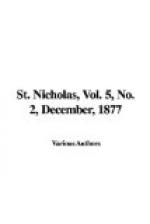After a flourish of trumpets, the Sicilian came upon the stage, which was arranged to represent a circle, or arena, and had three palm-trees in the middle. He was handsomely dressed in a costume of black velvet, trimmed with silver braid, and, as he looked around upon the audience with a grave but gentle expression, and went through with the Arabian salutation, which was to bear his right hand to his heart, mouth and forehead successively, there was perfect silence, so charmed were the people with his beauty and dignity.
Then an interpreter cried:
“The Christian will show you how, with his club, he killed a lion in the country of Damascus!”
Immediately following this came another flourish of trumpets and a striking of cymbals, as if to announce the entrance of the lion. Quickly the Sicilian sprang behind one of the three palms, whence to watch his enemy. With an attentive and resolute eye, leaning his body first to the right, and then to the left, of the tree, he kept his gaze on the terrible beast, following all its movements with the graceful motions of his own body, so naturally and suitably as to captivate the attention of the spectators.
“The lion surely is there!” they whispered. “We do not see him, but he sees him! How he watches his least motion! How resolute he is! He will not allow himself to be surprised——”
Suddenly the Sicilian leaps; with a bound he has crossed from one palm-tree to another, and, with a second spring, has climbed half-way up the tree, still holding his massive club in one hand. One understands by his movements that the lion has followed him, and, crouched and angry, stops at the foot of the tree. The Sicilian, leaning over, notes the slightest change of posture; then, like a flash of light, he leaps to the ground behind the trunk of the tree; the terrible club makes a whistling sound as it swings through the air, and the lion falls to the ground.
The scene was so well played that the wildest applause came from all parts of the audience.
Then the interpreter came in, and, throwing at the feet of the Hercules a magnificent lion’s skin, cried:
“Behold the skin of the lion that the Christian killed in the country of Damascus.”
The fame of the Sicilian reached the ears of the Bey of Tunis. But the royal dignity of the Bey, the reigning prince of that country, would not allow him to be present at exhibitions given to the common people. Finally, however, having heard so much about the handsome and strong Sicilian, he became curious to see him, and said:
“If this Christian has killed one lion with a club, he can kill another. Tell him that if he will knock down my grand lion with it, I will give him a thousand ducats”—quite a large sum in those days, a ducat being about equal to the American dollar.
At this time the Bey had several young lions that ran freely about in the court-yard or garden of his palace, and in a great pit, entirely surrounded by a high terrace, on a level with the ground-floor of the palace, a superb Atlas lion was kept in royal captivity. It was this lion that the Bey wished the Sicilian to combat. The proposition was sent to the Sicilian, who accepted it without hesitation, and without boasting what he would do.




